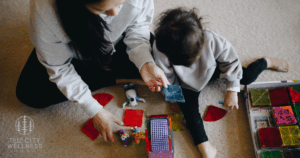Have you ever fallen in to a circular argument in your relationship that plays out over and over again? Do you ever feel like you try to solve the problem, change the conversation, or drop it, but it continues to resurface?
If so – you are likely experiencing yours and your partners attachment styles play out in real time. Attachment styles are rooted in your past, predominantly formed during the time you were a baby, and they tend to be most noticeable when you find yourself in conflict in your relationship(s).
The good news? Once you fully understand your attachment style, these dynamics begin to become more predictable, and even solvable, ESPECIALLY when encountering stress or tension in your relationship.
The Origins of Attachment Theory
The concept of attachment styles is grounded in decades of psychological research, beginning with the work of John Bowlby, a British psychiatrist and psychoanalyst. If you’re a research nerd, I strongly suggest looking into the science behind Attachment Theory because it is QUITE fascinating. In short — In the mid-20th century, Bowlby proposed that the bonds we form with our primary caregivers in early childhood significantly influence our emotional and social development and replay over and over in our relationships. He posited that these early attachments serve as a blueprint for how we relate to others throughout our lives.
Bowlby’s theory was further developed and validated by Mary Ainsworth, an American-Canadian developmental psychologist, whose “Strange Situation” study in the 1970s provided empirical evidence for different attachment styles. In this study, Ainsworth observed how infants reacted to brief separations and reunions with their mothers. Through these observations, she identified three primary attachment styles: secure, anxious, and avoidant. A fourth style, disorganized attachment, was later added to the framework to describe children who displayed a mix of anxious and avoidant behaviors, often as a result of inconsistent or traumatic caregiving.
Why It’s Important to Understand Your Attachment Style
1. Self-Awareness is Empowering
Understanding your attachment style is like unlocking a map to your inner relational world. When you know how your early experiences have shaped your behavior in relationships, you gain invaluable insights into why you may struggle in certain areas, such as trust, intimacy, or emotional regulation. This self-awareness is not just enlightening—it’s EMPOWERING and the first step toward making meaningful changes in your relational patterns.
2. It Can Transform Your Communication
Attachment styles don’t just influence how you feel in relationships; they also affect how you communicate. For instance, if you have an anxious attachment style, you may find yourself constantly seeking reassurance from your partner, which can lead to misunderstandings or conflict. On the other hand, if you have an avoidant attachment style, you might struggle to express your needs or emotions, preferring to keep a safe distance instead. Understanding your attachment style allows you to communicate more effectively, fostering deeper connection and making difficult conversations a chance for vulnerability and healing opposed to causing a rupture in the relationship.
3. It Provides a Path to Growth
One of the most empowering aspects of attachment theory is the understanding that attachment styles are not fixed. While they are deeply rooted in our early experiences, they can evolve over time, especially with conscious effort, a committed partner, and therapeutic support. Moving toward a more secure attachment style can lead to more satisfying relationships and improved emotional well-being.
4. It Guides You in Choosing Compatible Partners
Awareness of your attachment style not only helps you understand your own behavior but also guides you in your choice of partners. Knowing your attachment needs can help you identify partners who complement your style or work with your current partner to better understand each other’s attachment-related behaviors. This awareness can lead to healthier, more balanced relationships where both partners feel seen, heard, and valued. (Interested in learning more? The book “Attached” by Levine & Heller goes over dating among the various attachment styles in detail!)
The Question You’re Now Wondering – How Do I Identify My Attachment Style?
Curious about your own attachment style? Reflecting on your past relationships and how you feel and perceive emotions in yourself and others can offer valuable clues.
Consider the following questions:
- Do you find yourself craving closeness OR needing space in relationships?
- How do you react when your partner is distant or unavailable?
- Do you often worry about your partner’s feelings for you?
- Do you find yourself struggling with “grass is greener” mentality in relationships?
- How did your family treat emotions when you were a child? Were they freely expressed? Were they avoided? Were some acceptable while others were not acceptable?
- Who cared for you when you were upset as a child? Did you have a trusted adult to turn to? Were you often left to cope with hard feelings on your own?
These reflections can help you begin to identify your attachment style and predict how you may respond to challenging moments in your relationship. For a more in-depth understanding, consider taking the attachment style quiz offered through my website pop-up or scheduling an appointment with one of our therapists to further discuss this topic.
Okay, So Now What?
Recognizing your attachment style is a significant first step, but the journey doesn’t end there. If your attachment style is causing difficulties in your relationships, working with one of our therapists can support you in gaining the tools needed to foster growth, healing, and a healthy relationship. In sessions with your therapist, you’ll first identify your attachment style, then learn your attachment patterns and gain a deep understanding of how they show up in your relationship(s), as well as learn how to re-route and respond in a way that supports secure attachment with your partner.
If you’re ready to explore your attachment style further and work toward more secure relationships, I invite you to schedule a session with one of our therapists for individual or couples therapy. Together, you can embark on a journey to help you build the healthy, loving relationships you deserve.





